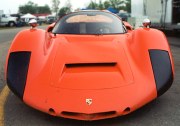
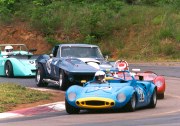
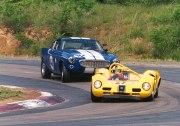
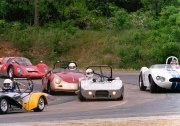
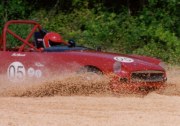
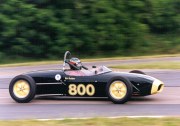
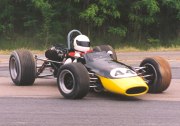
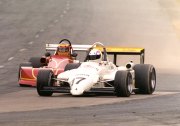
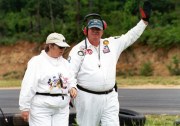
It is said that the Arctic-dwelling Inuit people have more than 20 highly nuanced words for snow, while we who live in more southerly climes must make do with one, assisted only by a few unimaginative modifiers. We who spend our weekends at Summit Point need to come up with a similarly rich vocabulary, except that ours should address the myriad subtle shades of "gray" and "gloom."
Coming off more than a week of spectacular days and cool nights, the forecasts decreed that the Tenth Anniversary Jefferson 500 would have a lower-intensity version of last year's weather: rainy Friday, cloudy Saturday, sunny Sunday. Instead it turned out to be almost a bookend: Friday was mostly a study in grays, Saturday the sun mostly prevailed, and Sunday kind of trickled away in a steady light rain that began around lunchtime and hung around until the day disappeared in the rooster tails of spray thrown up by the open-wheel Phil Hill Cup cars charging into the thickening fog.
The Jefferson 500 is vintage racing, a fast-growing phenomenon in many areas of motor sport, not just roadracing. "It's about the cars," said guest pro and popular TV racing commentator Bill Adam. "It's not about prize money or points or pleasing the sponsor. It's about the cars and people who love to race them." At the J5 they race in one or more of seven events, mostly one- or two-hour enduros with a few longish sprints thrown in. Eligibility rules vary with the event, but generally the cars must be at least 20 years old (see the official website for a detailed breakdown). Though this year schedules clashed again and SVRA was elsewhere, there were nearly full fields in all events.
The Jefferson 500 is also one of two auto races during the season for which the MARRC Safety Crew provides workers, the other being the SVRA Blue-Gray Challenge in the fall. Why cars? Because the vintage organizations have no corner workers of their own, we help the Sports Car Club of America safety crew handle the J5, and the SCCA helps us do the Blue-Gray. One reward is track time, which for us shows up as the annual MARRC Track Day.
Thanks go out to MARRC members Roger Bacon, John Capen, Howard "Doc" Weiss, and Mike and Connie Moscati, as well as all the SCCA workers, for helping create another safe and satisfying race weekend!
 |
It's disconcerting enough just to meet Henry Payne IV's Porsche 906E quietly guarding the paddock entrance. It's downright scary to see it glaring at you in your mirrors like some malevolent bird of prey. Enlarge the photo, or click here to wander around. |
 |
Rounding Turn 1 are the top four in Saturday's heat of the two-part Cunningham enduro, though not in final order. Travis Engen's red Lotus 23B, in second here, went on to erase his Y2K bridesmaid finish with a decisive 1-minute victory in this half and a 2-second squeaker on Sunday. Wesley Myers put his 1965 Corvette (#42) in second, and Phil Meany's green Aldon F100 (#68) was a strong third after a scary incident in practice. Larry Neviaser, leading here, brought home his Ginetta G16 (#22) just out of the money in fourth. |
 |
Gary Jebsen's reliable and very quick P1800 tends to disprove the notion that "Volvo" and "race car" are terms that don't go together. Here he's hot on the tail of Larry Kessler's Elva M8, which rounded out the top five on Saturday. On Sunday, however, Kessler failed to take a checker, while Jebsen charged through the drizzle to within 2.196 seconds of overall winner Travis Engen, and John Biggs brought his red and gold Porsche Speedster home in third. |
 |
The main difference between cars and bikes on lap 1 at Turn 1 is that fewer cars can fit through the corner. The level of chaos is just about the same. In Saturday's heat of the Briggs Cunningham enduro, Paul Stinson's Lotus Seven (#7) has squirted through, and Charles Bordin's Philson Falcon (#123) barely leads John Biggs's Porsche Speedster (#158). Meanwhile, Ed Mettelman (Porsche 906, #33) brakes hard to avoid piling on, and Ray Sokolowski opts for the discretionary part of valor, taking his rare, Corvette-powered Bocar XP-5 (#214) around the outside. |
 |
Summit Point's own kite-eating tree, the Turn 1 trap, usually proves as magnetic to four-wheeled Charlie Browns as it does to their two-wheeled counterparts. On Saturday, Fred Danovitz had the door slammed on an attempted inside pass in his #05 car, a 1964 MG, leaving his only option the spectacular, terminal moto shown here. Click the photo to see the complete sequence. |
 |
Here's one of Sir Jack's early takes on the mid-engine revolution, circa 1961. Thatcher Goddard swings into Turn 1 at the wheel of Bob Goeldner's Brabham Formula Junior during Saturday qualifying for the Phil Hill Cup. |
 |
Despite a spin in Turn 1 during the Phil Hill Cup qualifying session, Brad Baker put his Titan Formula B on the outside of the second row and came home second in the precipitation festival on Sunday. |
 |
Rick Crouch (March 76B, #11) casts a wary eye to his left as Dave Kane (Ralt RT4, #17) kisses the turn-in and then takes the classic line across the Turn 1 concrete. The scene is Friday practice for the Bobby Rahal Trophy. |
 |
Much as we might love roadracing, all day on the corner skates right up to the edge of "too much fun." SCCA's Kathy McLeod and MARRC/SCCA stalwart Roger Bacon stand down after Friday practice. |
Towards the end of the evening Brian Redman introduced ailing Summit Point maestro and former racer Bill Scott. The standing ovation was a reminder of how big a part Scott has played in many peoples' racing lives, amateur and pro alike. Just at a time when rides were beginning to grow scarce, Redman said, Scott offered him the opportunity to put together a vintage weekend, helping launch a successful second career as an event promoter. Over the past 10 years, the Jefferson 500 has remained more or less a handshake deal. Then Redman led the crowd in a moment of silent, concentrated meditation on Bill Scott's recovery. As you read this, why not take a moment and focus your own beam of good wishes in his direction?
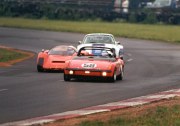 |
Though the track was damp, fortunately the worst of the rain held off until just past lunchtime. The first podium dash was the all-Porsche Eifel Trophy, run in conditions just as dark as shown here. Starting up the hill to Turn 10, the Brumos 914 (#58) is about to be lapped by Henry Payne IV's 906 (#39), who eventually would be bumped down to bronze by second-placer Jim Scott's 1973 911 (#14). |
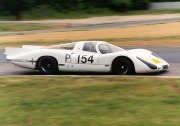 |
Henry Payne III grabbed the Eifel Trophy by nearly half a minute in his 1967 Porsche 907LH longtail. Thirty-three years ago this same car led a 1-2-3 sweep of the Daytona 24 Hours, piloted by one of the many Porsche all-star teams: Vic Elford, "Seppi" Siffert, Rolf Stommelen, Hans Herrmann, and Jochen Neerpasch. Though they were being eclipsed by 4-liter Ferraris and 7-liter Fords, the venerable 907s provided most of the high points in what was largely an unsatisfying 1968 season for the Stuttgart marque. |
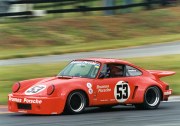 |
Michael Duffy speeds past the pit lane in the Brumos 911RSR (see a paddock view). Duffy garnered a first in class and fourth overall in the Eifel Trophy finale. |
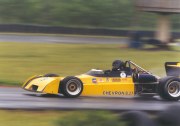 |
Bobby Brown charges through The Esses (we think he was driving a Chevron B27) on his way to the checker in the afternoon session of the Bobby Rahal Trophy dash, up from last place and 5 seconds ahead of morning winner Dave Handy's Ralt RT1. Brown turned a 1:11.8 qualifying lap -- down within striking distance of the absolute track record -- but Sunday's moisture dampened his best race lap to about 1:37. Click here for more open-wheel action. |
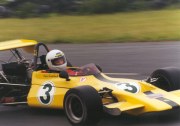 |
Kyle Kaulbach has the hammer down as he heads for the apex of Turn 9 in Sunday morning's session of the Rahal trophy. Kaulbach brought his Lotus 69 from fifth place in this heat to a podium finish in the afternoon. |
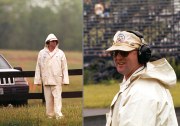 |
MARRC worker Mike Moscati seemed cheerful enough (right) as he departed for a solo stint on the outside of Turn 9. But after an hour of Marlboro Cup enduro, with only a fire bottle for company, a certain "Farr Out" stoic glaze had set in. |
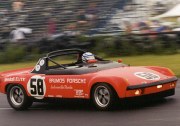 |
The Marlboro Cup looked like a small-bore replay of the Eifel Trophy, with Porsches taking 7 of the first 8 places. Bob Snodgrass in the #58 Brumos 914 bounced back from a disappointing 21st in the Eifel to a pole-to-flag victory in the Marlboro. Teammate John Hayt grabbed the silver in a 1970 914/6 GT, less than a minute behind, and the bronze went to Susann Miller in a 1968 911L. |
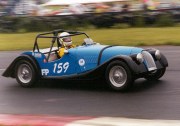 |
If you were looking for a symbol of "vintage racing" and no Bugattis or T-series MGs were available, you could do a lot worse than choose a Morgan. Here Peter Dunn and his 1962 4/4 romp through conditions not unlike the car's native English countryside. |
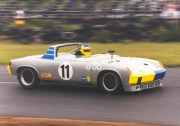 |
Let's see...if you raced a Porsche and were feeling flush with the entry fees, you could compete in no fewer than four Jefferson 500 events. After running in the Cunningham Cup, the Marlboro Cup, the Eifel Trophy, and the Wyer Cup, do you think you'd have had enough seat time? The G, M, and W stickers on Wayne Jackson's clean 914 machine show he chose to stop one race short of too much fun. |
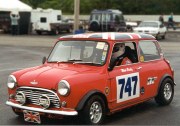 |
J5 veteran "Mini Cindy" Bauer wheels her popular Little Car With A Big Number, the splendidly Union-Jacked Mini-Cooper S, down the paddock road after practice for the Lola Cars Cup enduro. Bauer went on to take a hard-fought second place, less than 3 seconds behind winner Kent Baum's Triumph Spitfire, in Sunday's hour-long final. |
Ah, the John Wyer Cup. Therein hangs a tale. Normally it's the Sunday feature and the province of snarling turbo Porsches and purpose-built sports racers. The annals of racing will show that Dave Scholz won it in a 1977 Porsche 911, with Summit Pointer Dave Coleman's 914/6 placing second. So where were Saturday's fast ones? Already on the transporters or rapidly getting there. As the afternoon's weather continued to deteriorate, Scholz and Coleman were the only two drivers to grid their cars, and race officials truncated the hour-long enduro to an 8-lap sprint. In "calling the pack around" on the pace lap, Turn 10 was heard reporting it to be "exceptionally well-formed" coming into the front straight. Pleading literary license (plus the fact that the cameras were already dried off and safely stowed away), let's see how this account might have read if Sunday's heat had never happened...
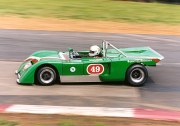 |
After missing the Y2K event due to another commitment, Bill Adam repeated his 1999 Wyer Cup victory in this 1971 Chevron B19, shown here with co-driver Brian Redman at the wheel. Rasim Tugberk took the silver, also in a B19. Lowell Blossom brought a pretty yellow one, which died in a Carousel moto, and Amalfi Racing's #96 car didn't grid. The Chevron factory made only 35 of these wicked little 2-liter go-karts, meaning more than 10% of all the B19s on the planet were at Summit Point! |
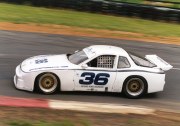 |
Another side of Dick Howe's Porsche 924 turbo -- specifically the side that doesn't belch great wads of crowd-pleasing flame. Shown here stepping out the tail as he enters Turn 5 in Saturday's John Wyer Cup session, Howe topped his class and grabbed the bronze corner of the podium overall. |
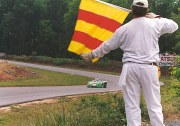 |
During Lowell Blossom's infield excursion, an unidentified SCCA worker shows the debris flag to leader Bill Adam, who's just cleared Turn 4 and is rocketing down The Chute. (Why does this part of the track always look steeper from the sidelines than it feels when you're driving it?) |
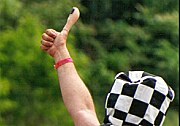 |
Finally, here's the obligatory "Doc's hat" shot: SCCA worker Alicia Politi and MARRC's own Howard "Doc" Weiss salute the Phil Hill Cup qualifiers on Saturday afternoon. |
And
here's a bonus question for MARRC workers: Ever wonder
what Rash Jr. dreams about at night?
Please send comments, questions, and especially caption and photo ID corrections to Stephen Moore.
MARRC
News © 2001 Mid-Atlantic Roadracing Club
All
photos © 2001 Stephen Moore